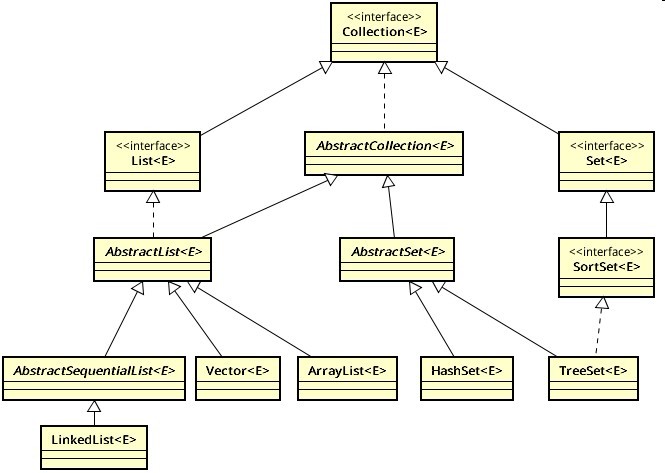1. 集合类概述
2. Collection接口
2.1 List篇
2.1.1 List遍历方式
2.1.2 ArrayList的实现原理
2.1.3 LinkedList的实现原理
2.1.4 ArrayList和LinkedList比较
2.2 List的使用场景
1. 集合类概述
Java中以一种比数组存储更复杂的方式来存储对象的一组对象—-“容器类”,其基本类
型有List、Set和Map,它们被组织在以Collection及Map接口为根的层次结构中,称之为集合框架。
2. Collection接口
Collection的层次结构图
2.1 List篇
List的特征是其元素以线性的方式的存储,集合中允许放重复元素。
List接口主要的实现类有:
- ArrayList() : 代表长度可以动态改变的数组;可以对元素进行随机的访问,向ArrayList
中插入与删除元素的速度慢。
- LinkedList() : 采用链表结构实现。其插入和删除的速度快。
2.1.1 List遍历方式:
(1)for循环遍历
/**
* List中的get(int index)方法支持取指定下标的元素
*/
1)使用一般for循环
for(int i = 0 ; i < list.size ; i ++) {
E obj = list.get(i);
}
2)使用增强型for循环
for(E obj : list) {
}
(2)使用迭代器(Iterator)
/**
* Collection集合接口继承了Iterator接口,允许集合被迭代
* 迭代方式如下:
*/
Iterator<E> it = list.iterator();
while(it.hasNext()) {
E obj = it.next();
}
2.1.2 ArrayList实现原理
ArrayList部分源码分析:1
2
3
4
5
6
7
8
9
10
11
12
13
14
15
16
17/**
* Default initial capacity.
*/
private static final int DEFAULT_CAPACITY = 10;
// 存放元素的数组
private transient Object[] elementData;
/* 构造方法,
* @param initialCapacity : 设置数组的初始容量
*/
public ArrayList(int initialCapacity) {
super();
if (initialCapacity < 0)
throw new IllegalArgumentException("Illegal Capacity: "+ initialCapacity);
this.elementData = new Object[initialCapacity];
}
从源码可以分析出:ArrayList采用一个Object型对象数组来存放元素,默认初始容量为10。1
2
3
4
5
6
7
8
9
10
11
12
13
14
15public boolean add(E e) {
// 当添加元素时判断数组容量超出可容纳范围时会自动扩容
// 具体会调用grow(int minCapacity)方法
ensureCapacityInternal(size + 1); // Increments modCount!!
elementData[size++] = e;
return true;
}
// 该方法会自动给数组扩大一倍,数组可被扩大的最大容量为Integer.MAX_VALUE
private void grow(int minCapacity) {
// overflow-conscious code
int oldCapacity = elementData.length;
int newCapacity = oldCapacity + (oldCapacity >> 1);
....省略部分代码
}
2.1.3 LinkedList实现原理
LinkedList采用双向链表结构来实现的,使用结点来存储数据域和连接前一个和后一个结点.1
2
3
4
5
6
7
8
9
10
11
12
13
14
15
16
17
18
19
20
21
22
23
24
25
26
27
28
29
30
31
32
33
34
35
36static class Node<E> {
E item; // 用来保存数据域
Node<E> next; // 下一个结点
Node<E> prev; // 上一个结点
....此处省略
}
// 代指第一个结点
transient Node<E> first;
transient Node<E> last;
// 这里只做add方法的讲解
public boolean add(E e) {
// 链接下一个结点
linkLast(e);
return true;
}
void linkLast(E e) {
// 保存当前的最后一个结点
final Node<E> l = last;
//创建一个新添加元素的结点,前一个结点为该链表的最后一个结点
final Node<E> newNode = new Node<E>(l , e , null);
// 将新结点作为最后一个结点
last = newNode;
// 如果未添加前最后一个结点为空,则说明此时链表没有元素,将新结点作为首结点
// 否则将新结点链接在末尾
if(l != null)
first = newNode;
else
l.next = newNode;
size++;
modCount++;
}
LinkedList数据结构是链式结构,具体查阅数据结构相关的书籍。
2.1.4 ArrayList和LinkedList比较
ArrayList和LinkedList的区别:
1.ArrayList是实现了基于动态数组的数据结构,LinkedList基于链表的数据结构。
2.对于随机访问get和set,ArrayList觉得优于LinkedList,因为LinkedList要移动指针。
3.对于新增和删除操作add和remove,LinedList比较占优势,因为ArrayList要移动数据。
2.2 List使用场景
如果涉及到“栈”、“队列”、“链表”等操作,应该考虑用List,具体的选择哪个List,根据下面的标准来取舍。
01) 对于需要快速插入,删除元素,应该使用LinkedList。
02) 对于需要快速随机访问元素,应该使用ArrayList。
03) 对于“单线程环境” 或者 “多线程环境,但List仅仅只会被单个线程操作”,此时应该使用非同步的类(如ArrayList)。
对于“多线程环境,且List可能同时被多个线程操作”,此时,应该使用同步的类(如Vector)。